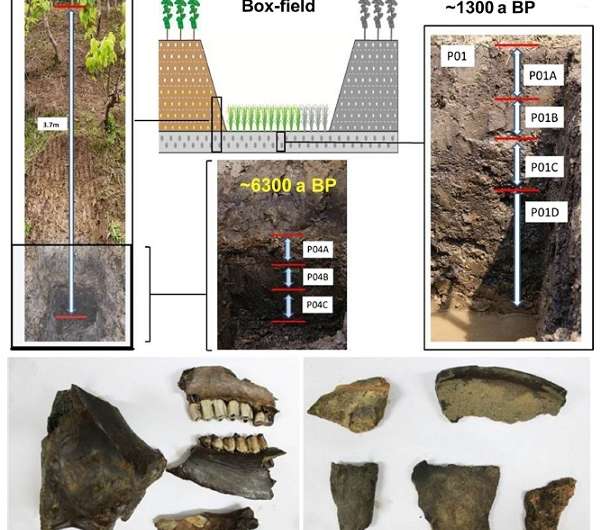This image shows buried Neolithic paddy soil, animal remains and pottery shards from Luojiajiao site in Tongxiang, Zhejiang province, eastern China. Credit: ©Science China Press
Modern intensive agriculture has generally led to a decline in farmland biodiversity, such as plants and animals. However, information on the impacts of human activities on soil microbial diversity is scarce and often inconclusive. This paucity is due partly to the difficulties in obtaining appropriate contrast samples for comparison.
A group of scientists from China and the U.S., led by Professor Yongguan Zhu of the Chinese Academy of Sciences, obtained buried Neolithic paddy soil and an adjacent, currently-cultivated paddy soil from a National Heritage Site, in Tongxiang, Zhejiang province in eastern China. By using high throughput metagenomics technologies, they examined microbial composition and functional diversity between these two sets of samples. They discovered that the currently cultivated soil contained 10-fold more microbial biomass than the buried one. Analyses based on both 16S rRNA genes and functional gene array showed that the currently cultivated soil had significantly higher phylogenetic diversity, but less functional diversity than the buried Neolithic one. The community structures were significantly different between modern and ancient soils, with functional structure shifting towards accelerated organic carbon degradation and nitrogen transformation in the modern soils.
Paddy soil is one of the most ancient land use types, and is currently feeding over 50 percentof the world's population. China has a rice cultivation history of up to 7000 years. This study implies that modern intensive rice cultivation has substantially altered soil microbial functional structure, leading to functional homogenization and the promotion of soil ecological functions related to the acceleration of nutrient cycling which is necessary for high crop yields.
More information: Yong-Guan Zhu et al, A buried Neolithic paddy soil reveals loss of microbial functional diversity after modern rice cultivation, Science Bulletin (2016). DOI: 10.1007/s11434-016-1112-0
Provided by Science China Press






















